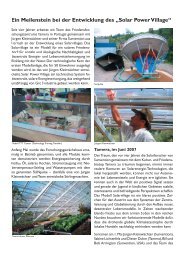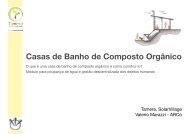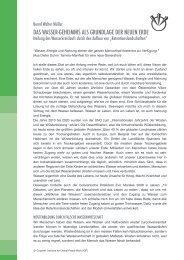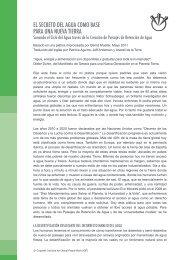Create successful ePaper yourself
Turn your PDF publications into a flip-book with our unique Google optimized e-Paper software.
arose of how long it would take for such a large hole to fill up with water. ‘Lake 1’, as it is<br />
known today, is located in the centre of our site. The idea of having to watch over a dusty,<br />
half-empty pool for years did not motivate us to take this first step towards the planned<br />
Water Retention Landscape. Then, to make things clear to ourselves, we had the idea of<br />
calculating the average annual amount of precipitation falling upon the catchment area of the<br />
retention space. In our minds we filled this water into containers, each with a capacity of one<br />
cubic metre, and placed them one after the other in a row that reached a length spanning<br />
the almost one thousand kilometres from <strong>Tamera</strong> to Barcelona. That was enough to launch<br />
us out of the system of scarcity thinking.<br />
In the very same year we began with the construction. In the first winter the lake and the<br />
adjoining earth-body filled up a good two-thirds with water. After the second rainy season,<br />
which had below-average precipitation, only a few centimetres to the high-water level<br />
remained to be filled. In the third winter, so much rain fell that we could have filled several<br />
more retention spaces. Today, only four years after the construction began, it is as if there<br />
had never been anything other than a water retention space. Many people who visit <strong>Tamera</strong><br />
for the first time cannot believe at first that it is anything other than a natural lake. On the<br />
terraces by the shore we have created an edible landscape and planted thousands of fruit<br />
trees and shrubs. Wild animals such as the otter have settled here. And the birds have<br />
returned: we now have 93 different species of birds in <strong>Tamera</strong>, some of which are very rare<br />
species found only in water-rich areas. Already within the first year a new seepage spring<br />
arose which since then has flowed continuously throughout the year.<br />
The construction of Lake 1 was only the beginning. Since then we have created a number<br />
of further water retention spaces. In 2011 we want to start the construction of a water<br />
retention space with approximately three times the capacity of Lake 1. This will signify the<br />
breakthrough from a landscape with a lot of water to a Water Retention Landscape that<br />
will then be able to absorb the entire rainfall of an average winter. A number of additional<br />
springs will form and of course the water table will rise, or at least will fall no further. A water<br />
retention landscape is fully realised when no more rainwater leaves the land but rather<br />
all water flowing away comes from springs.<br />
This next large water retention space will be located on the highest part of our land, so<br />
the water pressure will be high enough to irrigate of all of the land as long as this is still<br />
necessary, without having to supply additional energy for pumping. With the water from<br />
this highest-situated retention space the water level of the subsequent retention spaces will<br />
remain almost stable all year round.<br />
Here in <strong>Tamera</strong> we want to demonstrate a model of how it could look everywhere in the<br />
Alentejo and basically everywhere in the world. Without water there is no life. Positively said:<br />
With water there is life. We are becoming ever more able to see and maintain the picture that<br />
is emerging in front of our eyes if we ask ourselves ‘how does it look if we live with water<br />
and not without water?’ How quickly we come to visions of paradise and how quickly we<br />
can step out of scarcity thinking on all levels! I would like to conclude with a quote from<br />
Viktor Schauberger. It comes from an essay he wrote in 1934, from the book Das Wesen des<br />
Wasser (“The Being of Water”):<br />
“From water everything originates. Therefore, water is the universal natural resource of<br />
every culture or the foundation of every physical or mental development. The unveiling<br />
of the secret of water will put an end to all manner of speculation or calculation and their<br />
©<br />
Copyleft: Institute for Global Peace Work (IGP)











